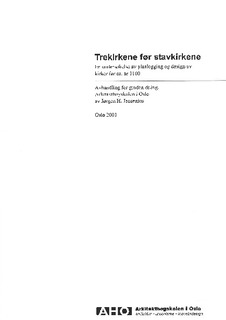Stave Church
WOODEN CHURCHES BEFORE THE STAVE CHURCHES

An investigation into the planning and design of churches prior to c. 1100 CE
Dissertation for the Degree of Dr. ing.
Oslo School of Architecture
Jørgen H. Jensenius
Oslo 2001
Download PDF of dissertation
Background and approach
For more than 160 years, researchers have conducted investigations into the churches which existed before the stave churches in Norway, and pointed out possible prototypes both at home and abroad. However, theories relating to origins often deal only with external form - the visible order. This dissertation looks into the aspects of planning and design conveyed in written sources and site material from before c. 1100 CE.
The desired result
The aim is to contribute to our knowledge about the form taken by early wooden churches.
Questions
- What was the relationship between the form and use of churches?
- Is it possible to reconstruct from written sources how churches were planned?
- Was the use of earth-fast post construction for churches common at this time?
- Did the churches have design schemes in common?
- Was there a theory behind the planning and design of the churches?
Thesis
The thesis is that knowledge about the churches’ form was transferred from prototypes through the repetition of constructional actions and ritual ceremonies in design and planning. If the thesis is true, similarity of form can be demonstrated by description of these actions as well as by outer and underlying form - the visible and invisible order.
The sources for the research
Written sources contain contemporary descriptions of processes of design and planning, while site material consists of documentation of visible and invisible order in traces of buildings.
Research methods
Contemporary written sources are read and descriptions of constructional actions and ritual ceremonies associated with the design and planning of churches are extracted. Traces of structures and their dimensions in the churches are investigated using site material.
Outline of the study
- Chapter 1 formulates problems, aims, questions, theses, sources and methods.
- Chapter 2 treats the use and form of the churches.
- Chapter 3 describes the actions which constituted preparations for church building.
- Chapter 4 presents wooden buildings and reconstructions of design schemes in the site material.
- Chapter 5 documents foundation techniques used in Norwegian wooden churches, and presents possible dimensions and relationships.
- Chapter 6 summarises and answers the questions relating to the planning and finished form of the churches.
Research results
- A clear relationship between the form and use of churches cannot be demonstrated.
- Written sources state that constructional actions and ritual ceremonies were performed, but impart little about how they were conducted.
- Churches constructed using earth-fast posts comprised just one variety of wooden building in Northern Europe in the period prior to c. 1100 CE.
- The site material shows that some of the investigated plans share dimensions and ratios, but the original design for the plans probably can not be reconstructed from the site material.
- The transferred knowledge was most probably not written down and was therefore not developed into a theory.
The study’s conclusion
The dissertation reveals that church building was part of an experience-based tradition wherein knowledge about the buildings’ visible and invisible order was transferred from prototypes through imitation of a number of actions. Shared dimensions and ratios in some of the church plans may be representative of such transferred knowledge.
Further research
Questions arising from the study’s conclusions include when and why the use of earth-fast posts in the construction of chapels and churches ceased after about 1100 CE. The dissertation’s approach can be used generally to describe the transference of knowledge about form to churches.